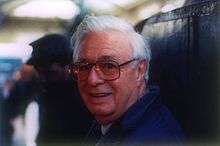Patrick Whitehouse
| Patrick Whitehouse OBE | |
|---|---|
 | |
| Born | Patrick Bruce Whitehouse |
| Nationality | British |
| Occupation | RAf officer (navigator); building company owner |
| Known for | Construction safety; Railway preservation |
| Notable work | Birmingham Railway Museum |
| Home town | Birmingham, West Midlands |
| Children | Michael, Maggy |
| Awards | Officer of the Order of the British Empire |
Patrick Bruce Whitehouse OBE (1922–1993) pioneered the preservation of disused railway branch lines, and the restoration to working order of the finest of Britain's steam locomotives after they were replaced by diesel locomotion in the 1960s.
Career
Whitehouse reached the rank of Squadron Leader in the Royal Air Force during the Second World War, navigating Lancaster bombers. After his tour of duty, while navigating a transport plane he was shot down in the Mediterranean and survived for four days in a life raft before being rescued. His colleague, the pilot, died on the second day.
For much of his life, Whitehouse ran the family building business: B. Whitehouse and Sons, being appointed OBE in the 1960s[1] for his campaign for safety regulations on building sites.
Railway preservation
In 1951, Whitehouse and other railway enthusiasts formed Britain's first railway preservation society at the Talyllyn narrow gauge slate railway in mid-Wales. He became vice-president of the society and went on to help with the restoration of the Ffestiniog Railway in North Wales and the Dart Valley Railway in Devon.
Whitehouse purchased Great Western Railway 4500 Class Small Prairie Tank No.4555, and then bought Castle Class No.7029 Clun Castle for its scrap price of £2,400. Both were intended to be used on the Dart Valley Railway, but inlight of his campaign for main line steam preservation that included face-to-face meetings with Dr. Beeching, then chairman of British Rail, he stored them at Tyseley TMD.
The residual elements of Tyseley depot became Birmingham Railway Museum,[2] a 16-acre (65,000 m2) site equipped to preserve and maintain main line steam engines. There he led a team which restored the LMS Jubilee Class class No.5593 Kolhapur, which with inspiration from his collection of photographs artist Terence Cuneo painted her climbing the Lickey Incline.[3] By the 1970s Birmingham Railway Museum housed up to 15 locomotives, and now leases engines to preservation lines throughout Britain. It is also the home of the Shakespeare Express on the BR main line from Birmingham to Stratford.[4]
Whitehouse was the author or co-author of 53 books on railways,[5] and built up a collection of more than a quarter of a million photographs of British and foreign railways. Whitehouse co-presented the BBC1 Children's programme Railway Roundabout with John Adams.[6]
In the 1980s his travels in China led to a long-standing friendship with the China Railway Publishing House in Beijing, and a treaty of friendship between Birmingham and the north-eastern city of Changchun, Manchuria. His book, China By Rail was co-authored by his daughter Maggy Whitehouse. His son Michael Whitehouse is a lawyer specialising in rail transport,[7] and non-executive director of the Rail Freight Group.[8]
References
- ↑ The Times 17 August 1993
- ↑ http://www.tyseleylocoworks.co.uk/tlw/brm.htm
- ↑ http://www.military-art.com/mall/more.php?ProdID=9050
- ↑ http://www.shakespeareexpress.com/se.htm
- ↑ http://www.amazon.com/s/ref=ntt_at_ep_srch/183-2752189-6412441?ie=UTF8&search-alias=books&field-author=P.+B.+Whitehouse&sort=relevancerank
- ↑ http://www.ltmuseumshop.co.uk/LTM/World_cities/DVDs/Product/Railway-roundabout-DVD-box-set.html
- ↑ http://www.wragge.com/lawyersearch_michael_whitehouse.asp
- ↑ http://www.festipedia.org.uk/wiki/Michael_Whitehouse